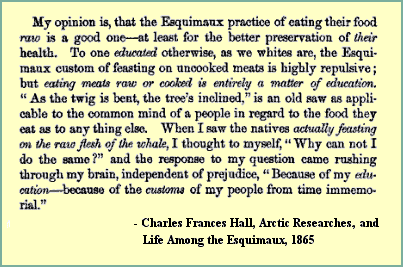Eskimo / igloo

Esquimau, pl. Esquimaux – An Indian of any of the tribes inhabiting arctic America and Greenland. The term originally designated the aboriginal inhabitants of Labrador. — Webster, 1882
 The Eskimo are a tribe of peoples who inhabit the Arctic coastal regions of Alaska and Canada, and parts of Greenland and northeast Siberia. In modern times, Eskimo is often perceived as a derogatory term, based on the etymology of the word as meaning “eaters of raw meat.” While Inuit (or Innuit in Laura’s day) may be an acceptable alternative to Eskimo, it applies only to the Inuit-speaking peoples of Canada and Greenland. In parts of Alaska and Arctic Serbia, Inuit is not spoken. The term Eskimo is inclusive of the Inuit of Greenland and Canada, the Yupik of Siberia, Russia, and Alaska, and the Alutiiq of south-central Alaska. In addition to language, there are cultural and ethnic differences between the Inuit and Yupik.
The Eskimo are a tribe of peoples who inhabit the Arctic coastal regions of Alaska and Canada, and parts of Greenland and northeast Siberia. In modern times, Eskimo is often perceived as a derogatory term, based on the etymology of the word as meaning “eaters of raw meat.” While Inuit (or Innuit in Laura’s day) may be an acceptable alternative to Eskimo, it applies only to the Inuit-speaking peoples of Canada and Greenland. In parts of Alaska and Arctic Serbia, Inuit is not spoken. The term Eskimo is inclusive of the Inuit of Greenland and Canada, the Yupik of Siberia, Russia, and Alaska, and the Alutiiq of south-central Alaska. In addition to language, there are cultural and ethnic differences between the Inuit and Yupik.
Mary and Laura Ingalls mention Eskimos, igloos, and raw fish while on one of their fresh-air outings during a break in the blizzards of the Hard Winter. They may have learned about Esquimaux – the accepted spelling at the time – from Pa’s big green animal book, The Polar and Tropical Worlds: A Description of Man and Nature. Eskimos are featured exclusively in more than one chapter, including information on the eskimos’ consumption of raw fish and how to construct an igloo. One chapter includes portions of Charles Francis Hall’s Arctic Researches, and Life Among the Eskimaux, quoted at left.
Igloo. Hall’s description of the construction of a snow hut or igloo, built by the Innuits near Wager Bay, about fifty miles south of the Arctic Circle, is as follows:
After making trial of several banks of snow, by plunging in their long knives, on finding the proper compactness, they cut blocks two to two and a half feet in length and about eighteen inches in thickness. One set is cut from the spot on which the igloo is to be built, its floor being thus sunken eighteen inches below the general surface. In placing the blocks around this excavation, of about ten feet diameter, the first tier is made up of those which, by increasing regularly in width, form a spiral from right to left. They are laid from within, each being secured by a bevel on the one last laid and another bevel on the next one below. The joints are well broken. The blocks incline inwardly, thus regularly diminishing the diameter of the igloo and fitting it for the dome or keystone. Thirty-eight blocks were used. For ventilation, a small hole is usually made by the spear. The crevices are well-filled with snow within and without, making it nearly an air-tight structure. For a window, a small opening cut in the dome is filled in usually with a block of clear ice; in some cases with the scraped inner linings of the seal; this last makes a light on which the frost does not settle as upon the ice-blocks. The passage-way to the igloo is always long and points toward the south. The Repulse bay natives shovel up much more snow upon the hut than the Greenlanders do. The igloo lamp is sometimes nothing more than a flat stone, about six inches in length, places in a niche cut out of the wall, and having on it a little dry moss for a wick, which is supplied with oil by a slice of blubber from the bear or the seal. A stone lamp of better form, although poor enough, will give something of a fair light and warmth. — Charles Francis Hall. “Igloo.” The American Naturalist (May 1880), 334-335.

Eskimo (TLW 16)
igloo (TLW 16)

